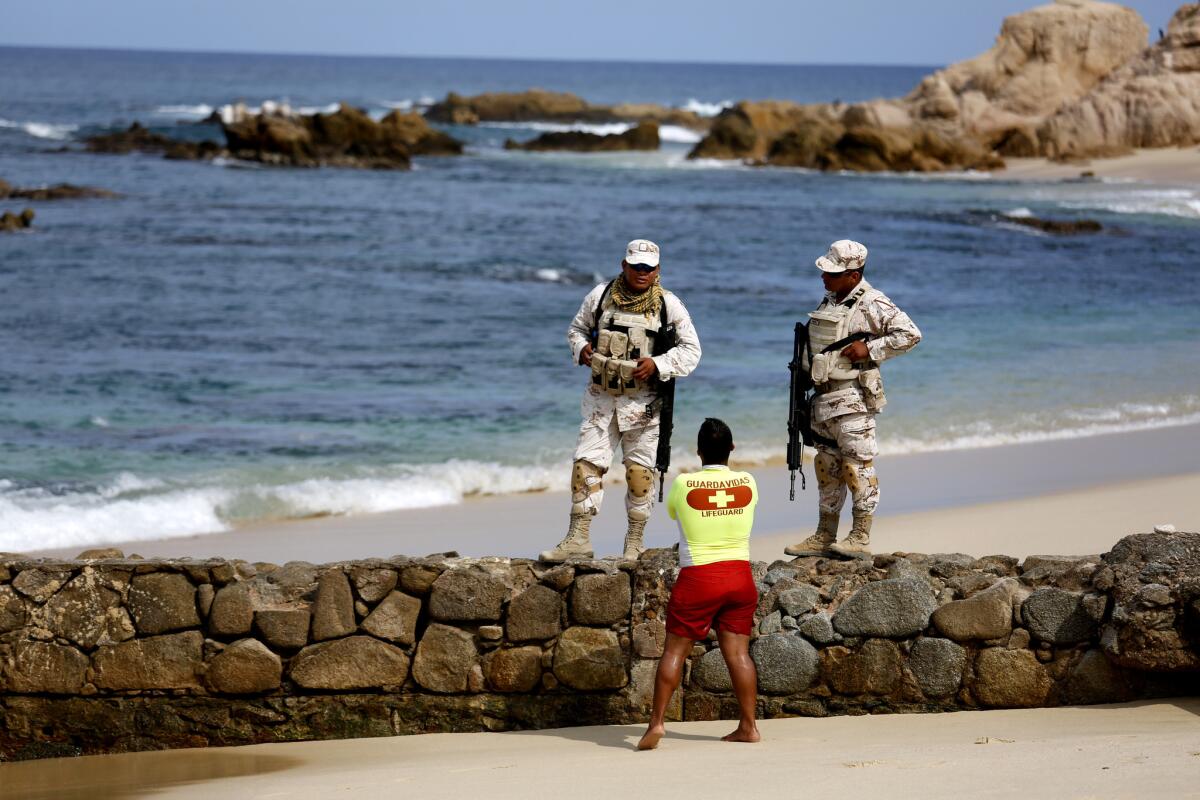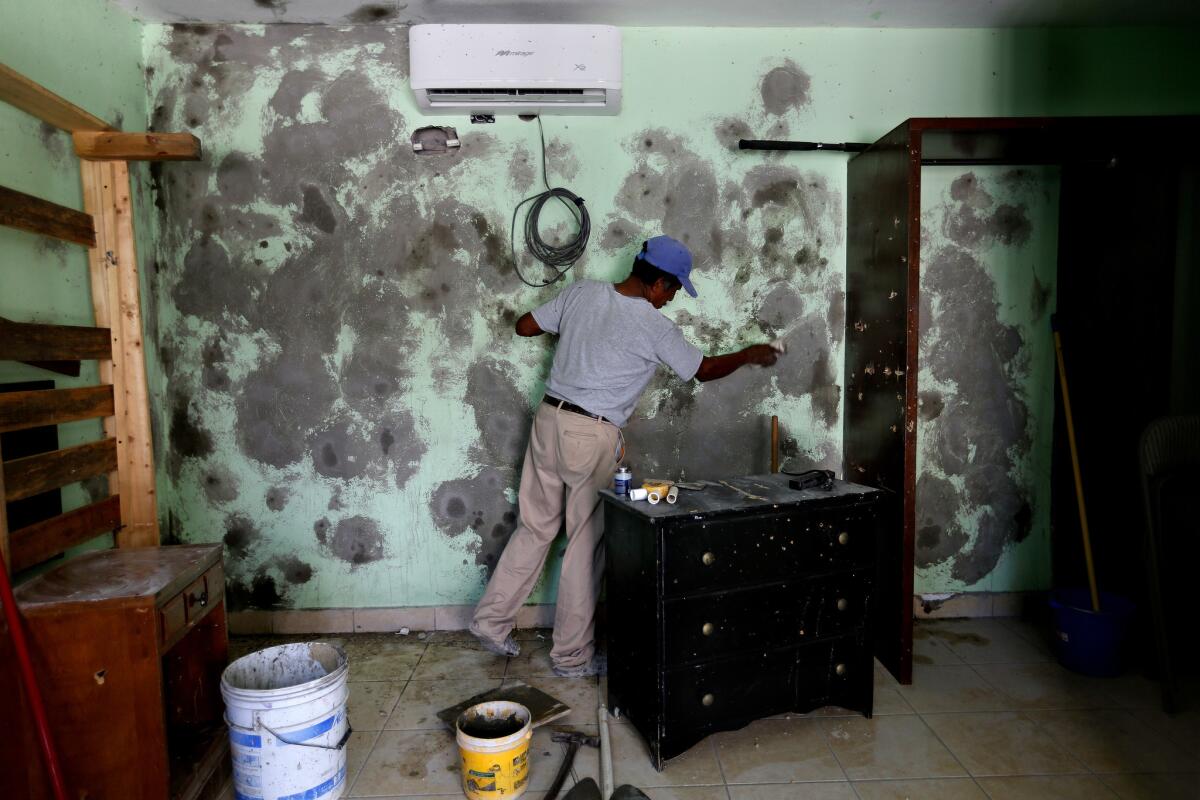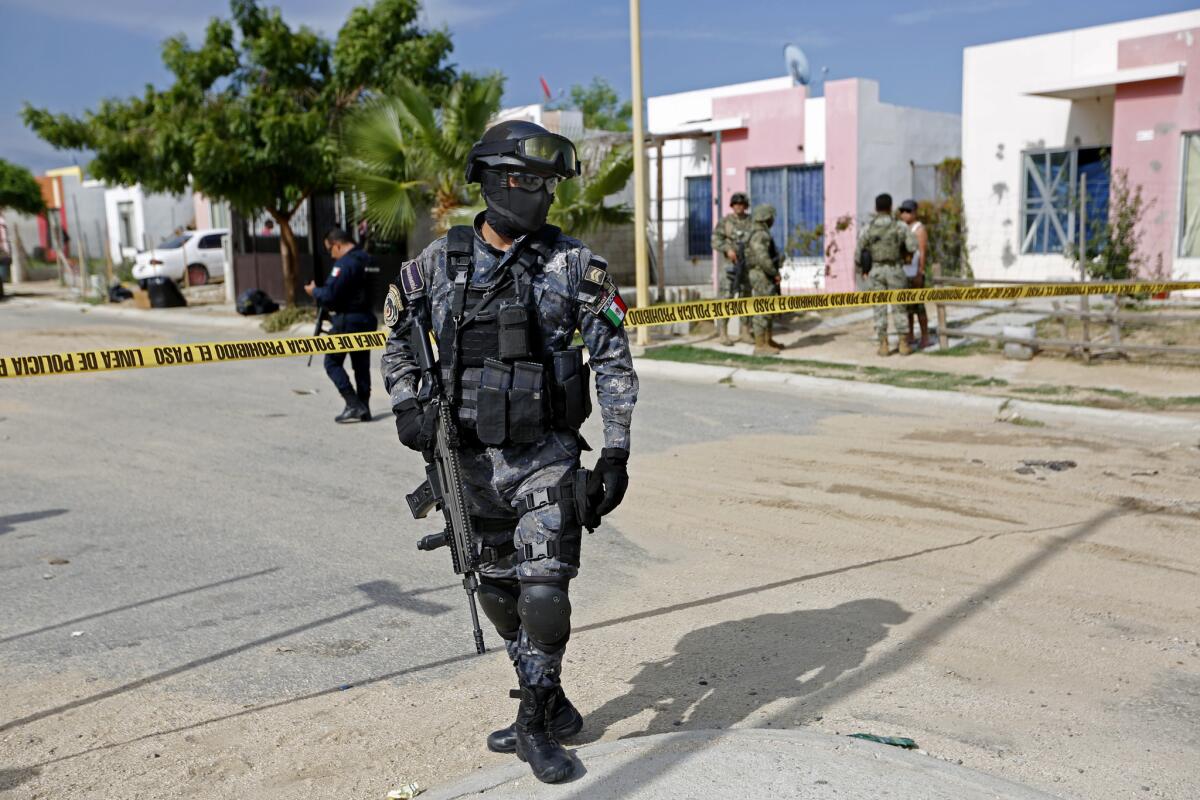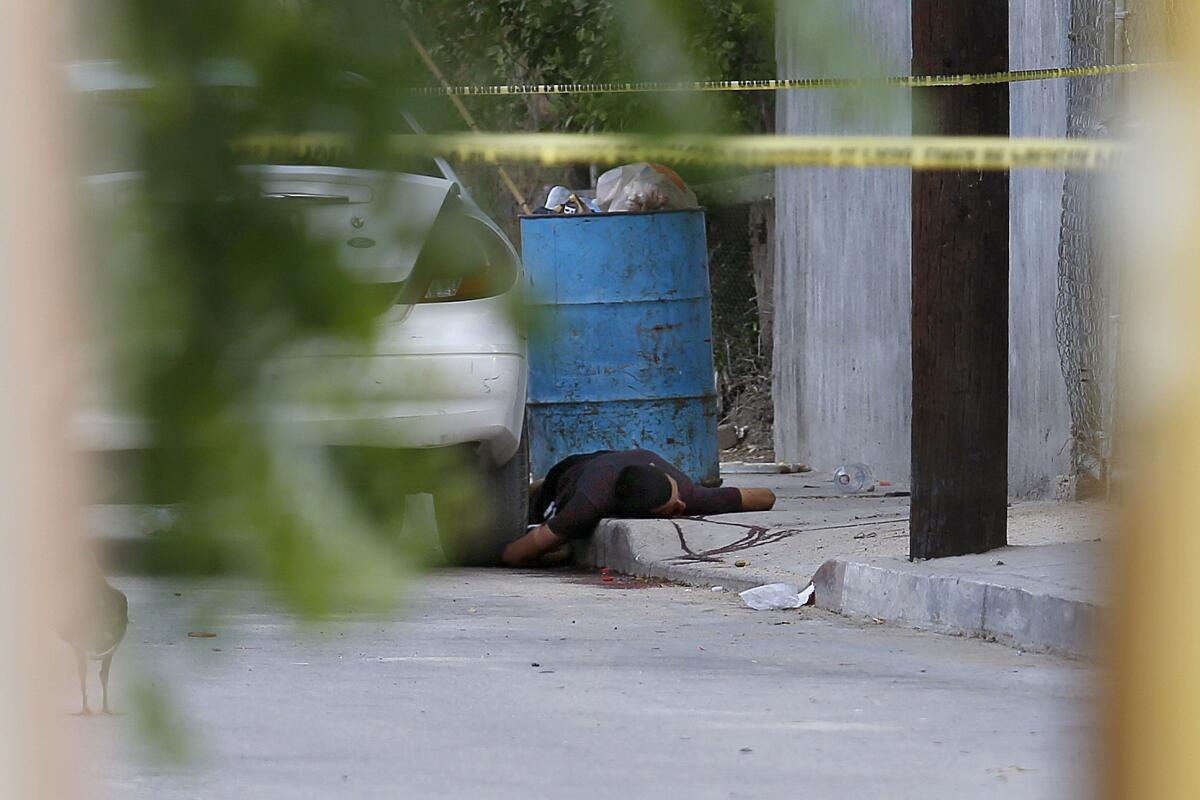Los Cabos is no longer a haven from Mexicoâs bloodshed

The Mexican Army patrols Palmilla Beach where recently three men were killed by a group of men with automatic weapons in San Jose del Cabo.

On a recent balmy afternoon in Los Cabos, as tourists and locals frolicked in the sparkling blue sea, a group of men toting automatic weapons stormed onto a crowded beach.
By the time the attackers fled, three men lay dead beneath a grove of palm trees â another sign that the violence roiling other parts of Mexico has arrived at one of the countryâs most prized and protected tourist resorts.
Los Cabos, a municipality that encompasses the cities of Cabo San Lucas, San Jose del Cabo and the 20 miles of beachfront resorts between them, has morphed into a battlefield since the arrest last year of drug kingpin Joaquin âEl Chapoâ Guzman.
Guzmanâs Sinaloa cartel was once so firmly planted in the state of Baja California Sur that he and other cartel leaders vacationed here safely â along with more than a million American tourists each year. But since Guzmanâs arrest and extradition to the U.S., the cartel has fragmented into warring factions, who are fighting each other as well as gangsters aligned with the emergent Jalisco New Generation cartel.
Although none of the recent violence has explicitly targeted tourists â the only known American victim was wounded in the leg by a stray bullet in March â the U.S. State Department last week warned Americans to take extra precautions when visiting Los Cabos. The department also issued a travel warning for Cancun, which this year was the site of a nightclub shooting in which several foreigners died.
Baja authorities say drugs, firearms and trained hit men have been arriving by ferry from Sinaloa state, just across the Sea of Cortez, fueling record levels of killings in what is still one of Mexicoâs most sparsely populated states, despite a steady stream of Mexican migrants who come to work in the resorts and escape violence or poverty in their home states.
The government launched 232 homicide investigations in the state from January to July, up 250% from the same period last year, and up more than 1,000% from five years ago.
This year, the state is on track to record an annual rate of 57 killings per 100,000 people â roughly eight times that of Los Angeles.
The vast majority of the violence is playing out in the poor desert hillside communities that house resort workers, far from the beaches that have made this region a magnet for business moguls and Hollywood stars.
Last weekend, a string of killings in those poor neighborhoods took 16 lives over three days. One of those slain was Jose Mauricio Savala Espinoza, 20, who was shot in the head Sunday afternoon near a Baptist church in San Jose del Cabo, three miles inland from a strip of $1,000-a-night hotels.
After the killing, as neighbors peered behind police tape to catch a glimpse of the body and investigators searched for bullets, the victimâs mother erupted in screams.
âMauricio! Why?â cried Norma Espinoza Escarrega, 47, clutching her face.
She said she and her husband came to Los Cabos from Sinaloa 23 years ago to work in a tortilla factory. Jose Mauricio, one of their four children, had fallen in with gangsters despite her warnings that it could cost him his life.
âI told you,â she wailed, as a relative rubbed her back. âMy God.â
To combat the violence, the government is building a new base for the Mexican marines in the region, and local hotels have helped pay for additional federal troops.
Even so, the violence has crept into the tourist zones, where menus are printed in English and prices are given in dollars. In March, police and armed gangsters clashed in the lobby of the Hyatt Ziva, a $400-a-night resort in San Jose del Cabo. In June, two severed heads were discovered in a cooler in the heart of the tourist zone in Cabo San Lucas.
The recent State Department warnings have officials worried about the potential impact on the countryâs $20-billion-a-year tourism industry. There are 20 new hotels planned in Los Cabos, including branches of the Ritz-Carlton and Four Seasons, projects that officials say will add 4,000 hotel rooms over the next two years.
Mexican authorities have gone to lengths to portray the violence as affecting only those involved in the drug trade.
Rodrigo Esponda, managing director of the Los Cabos Tourism Board, said that unlike the recent terrorists in Europe, Mexicoâs gangsters rarely purposefully target general society.
Others have suggested there were political motives behind the travel warnings. In August, Mexican Tourism Secretary Enrique de la Madrid told El Universal newspaper that the travel advisories might be part of President Trumpâs negotiating tactics as the U.S., Canada and Mexico thrash out changes to the North American Free Trade Agreement.
Aside from the tourists, an estimated 200,000 Americans live throughout the Baja California peninsula. Most in Los Cabos say the violence hasnât touched them.
------------
FOR THE RECORD
12:15 p.m. Sept. 1: An earlier version of this article said 200,000 Americans live in Los Cabos. That many Americans live throughout the entire Baja California peninsula.
------------
On a recent afternoon at Palmilla Beach, the same place where the deadly gunfire erupted weeks earlier, Cindy Slausen relaxed in a chair as her towheaded toddler son played in the sand.
âI feel safer here than in California,â said Slausen, 39, who moved here with her husband a few years ago and now runs a nanny service that caters to foreigners.
âTheyâre killing each other,â added her friend, Brent Piece, 60, a retired Canadian whose young children were splashing in the waves. âUnless youâre dealing drugs here, you have no problem.â
That foreigners feel so removed from the violence speaks to the wide economic gulf here and across Mexico. Every evening, giant buses painted with the fanciful names of resorts â Secrets, Dreams, One and Only â ferry maids, groundskeepers, waiters and pool boys back up to dirt roads lined with houses built of gray concrete blocks.
On a recent muggy morning, Father Juan Martinez Lara stood outside one such home sprinkling holy water over the bodies of Edwin Guerrero Burgoin, 22, and his uncle, Juan Jose Burgoin Fausto, 47, who lay side by side in matching wooden caskets.



Every day, sometimes twice a day, families come to Martinez in tears, asking the Catholic priest to preside over another rosary or funeral. This morning, congregants had quietly warned that the Burgoin family was wrapped up in the drug trade, and that it might be unsafe for Martinez to visit their home.
When the priest finished praying, the mother of the older man leaned against his casket, touching his face with her hand.
âMy son,â she whispered.
For years, Baja California Sur was one of the safest states in Mexico, far removed from the violence that erupted in other regions after former President
âWe were spectators,â said Los Cabos Mayor Arturo de la Rosa Escalante. âWe watched it on TV.â
De la Rosa believes there are important reforms to be made to the municipalityâs local police force â he recently fired 47 of the agencyâs 643 officers who were deemed incompetent or involved with the criminal groups â but he mostly blames the explosion of violence on outsiders.
âThey have come from Sinaloa to fight here and die here,â he said.
Some fear that Los Cabos could become like Acapulco, the Pacific Coast resort that has become Mexicoâs homicide capital as warring criminal groups battle for control.
Security analyst Alejandro Hope said a better analogy might be the border city of Juarez, where hundreds of thousands of people from other parts of Mexico came in the 1980s and 1990s to work low-wage factory jobs. The city descended into violence in part because criminal groups found easy recruits in the children of those workers, who lacked the traditional family networks to care for their kids.
Hope said the violence in Los Cabos shows that the governmentâs successful efforts to attract foreign investment in tourism and manufacturing could be undermined by gaping income inequality and the governmentâs inability to contain criminal groups.
âItâs private splendor and public squalor,â Hope said. âYou have an underclass that is a breeding ground for criminal activity.â
For now, people are still coming to Los Cabos â both tourists and the workers who serve them.
Just before sunset one day this week, tourists from California, Pete Lara, 43, and Andy Franks, 32, enjoyed two-for-one beers as bikini-clad women danced on a raised stage.
The friends said that they had taken the precaution of avoiding the highway at night, but that they both felt safe.
Joel Reyes, 32, does not.
Thin, with scuffed cowboy boots and darkly tanned skin, he arrived two weeks ago from Oaxaca to work construction. He spent five years here while he was in his 20s and had earned enough to buy a plot of land back home. Now he was determined to work three more years to earn enough to build a house.
But things felt different now, he said as he took a seat in a plastic chair for Mass at a humble Catholic church.
âI donât leave at night,â he said. âI donât go out drinking. I go from my job to my room. And from my room to my job.â
Cecilia Sanchez of The Timesâ Mexico City bureau contributed to this report.
Twitter: @katelinthicum
ALSO
Mexico signals tougher stance on NAFTA, may pull out of talks if Trump moves to scrap deal
The 1985 murder of a DEA agent still haunts Mexico. Finally, a drug lord gets sentenced in the case
Sign up for Essential California
The most important California stories and recommendations in your inbox every morning.
You may occasionally receive promotional content from the Los Angeles Times.








